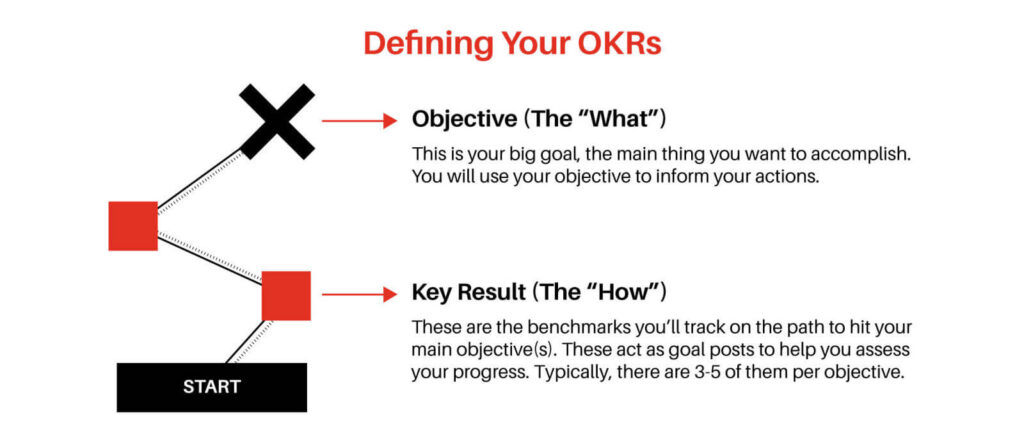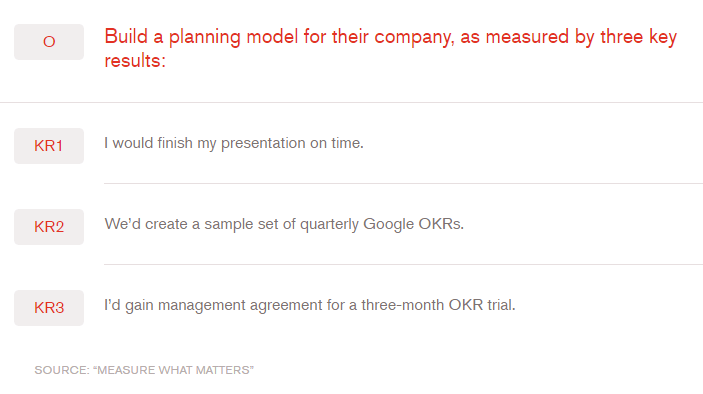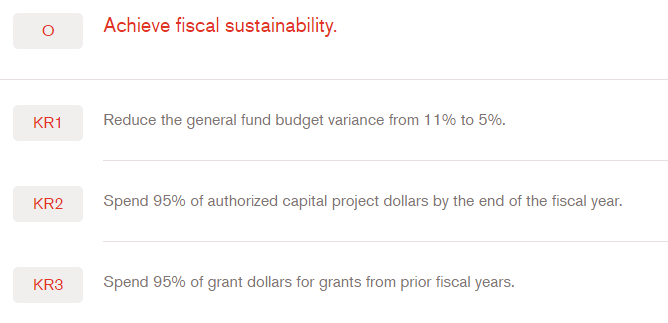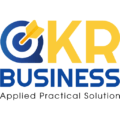The definition of “OKRs” is “Key Goals and Results” – This is a collaboration goal-setting tool used by teams and individuals to set challenging, ambitious goals with measurable results. OKR is how you track progress, create alignment, and encourage participation around measurable goals.
Whether it’s an office, software engineering, or nonprofits organization, OKRs work the same way to set goals at multiple company levels. They can also work for personal goals and can even be used by individuals to get things done in places where senior leadership has not yet used them.
A goal is simply what will be achieved, no more and no less. By definition, goals are significant, specific, action-oriented, and (ideally) inspiring. When properly designed and deployed, they are a vaccine against faint thinking and blurred execution.
Benchmark key results and track how we achieve our goals. Effective KRs are specific and time-limited, positive but practical. On top of that, they are measurable and visible. Can you meet the requirements of the key result or not; there is no gray area, there is no room for doubt. At the end of the specified period, usually a quarter , we check regularly and score the key results as completed or not.
In the event that a goal can last, rolling over for a year or so, key results develop as work progresses. Once they are all accomplished, the goal is necessarily achieved.

Who created OKRs?
OKRs were created by Andy Grove at Intel and taught to John Doerr by him. Since then, many companies have adopted them, including Allbirds, Apartment Therapy, Netflix, and inspiring nonprofits like Code for America.
From the beginning in “Measuring What Matters, “Doerr writes about “MBOs” or “Targeted Management.” MBOs was the spiritual child of Peter Drucker and provided Andy Grove with a basis for his final theory of OKRs. In fact, Grove’s name was originally “iMBOs”, for Intel Management by Objectives. However, despite the original reverence name, Grove made some key differences between the two names he passed on to Doerr.
Grove rarely mentions goals without forcing them into “key results,” a term he seems to have set himself. The main difference between MBOs and OKRs is that the latter are quarterly, not annual, and they are divorced from compensation.
Doerr was the creator of the name “OKRs”, for which he gathered Grove’s vocabulary.
The most famous story about OKRs was Doerr introducing philosophy to the founders of Google in 1999. Gathering around a table tennis table doubled as a boardroom table, Doerr presented a PowerPoint to the young founding team, which included Larry Page, Sergey Brin, Marissa Mayer, Susan Wojcicki and Salar Kamangar.
Doerr’s key objectives and results for a PowerPoint presentation are as follows:

Google then sets up its corporate strategy with this management framework and the rest is history.
OKR example
But what are some other high-level examples?
The city of Syracuse, New York recently set this goal: “achieve financial sustainability”. Financial sustainability is a big goal for any government, locality or otherwise, but it must be measurable. That’s why Syracuse is using Key Goals and Results.
When written, along with their Key Results, Syracuse’s OKR looks like this:

As discussed earlier, OKRs can work for all industries and even personal goals.
OKR Personal Goals
Doerr was asked about his personal OKR in an interview on Recode Decode. He replied: “My daughters have all left the house, but I have read and I believe that having dinner together is a good thing. So I set up an OKR, sharing it with my team to stay home for dinner before 6:00 p.m.m. 20 nights a month and being there, turning off the phone. I put a switch on the router. We closed the internet to the whole house.
“It’s not just quantity but quality,” he added.
This personal goal will be written like this:

And while it was a “personal” OKR, Doerr was transparent from the start. Not only did he share it with his colleagues and family, but he also shared it in an interview.
Industrial OKRs
For other examples of industry-specific company OKRs, click here.
Are there different types of OKRs?
OKRs can be two states, committed or aspirational.
Those who commit are just like their names suggest – commitment. When classified at the end of the cycle, OKRs commit to expect to have passing points.
Ambitious targets, on the other hand, are sometimes referred to as stretching targets or “moonshots.” The path to an ambitious OKR is expected to be forged because no one else has been there before. They can also be long-term and live beyond the OKR cycle or even be transferred between team members to prolong employee participation.
To learn more about the committed and ambitious versions of Key Goals and Results, click here.
What OKR tools are available?
If you’re looking for some OKR tools to help you set ambitious goals, check out these OKR trackers for individual goals and smaller teams, and these tools for larger businesses.
How do you score OKRs?
Andy Grove’s OKRs scoring method is a simple “yes” or “no” approach. However, there are also many ways to score them — namely the “Google method”.
To learn more, click here.
Are OKRs bound to compensation?
Unlike other performance management frameworks, such as balance score points (BSC) vouchers, OKRs are divorced from compensations such as wages and bonuses.
To find out why, click here.


